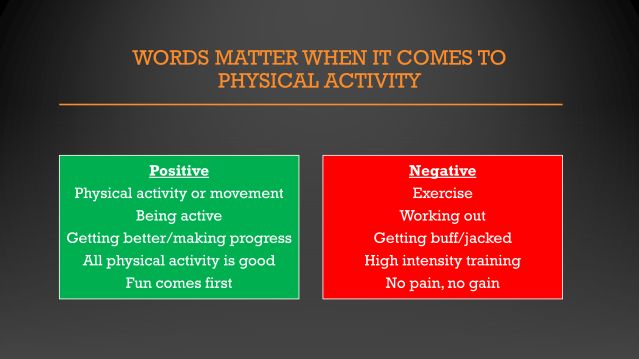Health
The Mindset for Healthy Movement
A physically active life depends on the right mindset.
Posted September 2, 2024 Reviewed by Lybi Ma
Key points
- In our consumer culture, the focus of exercise is typically aesthetics and purchasable products.
- Mindset factors play an invisible but powerful role in our physical activity patterns.
- Our word choices, reasons, and benefits we perceive are three mindset factors affecting physical activity.
The secret language supporting physical activity.
Intuitively, many people think that a decision about physical activity begins with the purchase of exercise equipment or perhaps a gym membership. This is how millions start their exercise resolutions each year, only to frustratingly find in the subsequent weeks and months that these purchases have too often gone to waste.
Counterintuitively, the better start to a more physically active lifestyle is carefully choosing the words you use when thinking about physical activity. Words have emotional meaning to us, far weightier than their generic definitions found in a Webster's Dictionary entry. For a competitive athlete, for example, words and phrases such as exercise, training, or pushing for personal records might elicit a surge of energy and motivation. Yet for another person whose formative experience with exercise was being picked last for the softball team in high school gym class, the same words may carry heavy negative connotations. What are your connotations about words associated with physical activity? What physical activity language do you find most and least inspiring? Appreciate that if you choose the wrong words for yourself, even with the right equipment, goals, and interpersonal support, you're less likely to succeed with a physical activity program.
When it comes to physical activity, words matter. More than most of us consciously realize. Even the simple vocabulary you choose will shape how you think, feel, and behave towards physical activity. Select the language you use about physical activity just as deliberately as you might choose the right shoes or facility.
As highlighted in the figure below, begin your physical activity journey by adopting personalized language to help you think of it more like recess and less like homework.

What are you fighting for?
The second piece of the physical activity mindset is consciously choosing your "whys" (that is, personalized reasons and rewards). By default, many of us feel compelled to engage in more physical activity for reasons imposed upon us by other people and the broader health culture around us. This approach is rarely effective long-term. Even when these "whys" come from well-intended people—such as our doctors or romantic partners—other people's reasons usually do not carry the same conviction, create the sustained emotions, or offer the same intensity of perceived rewards as the whys that we can identify for ourselves.

Instead of the dominant cultural benefits dictated to us about why we should be more physically active, what are better options? The figure above presents a simplified comparison of conventional versus more personal whys about physical activity to get you started. The overwhelming physical activity pressures towards weight loss, appearance, sexuality, and muscularity, and treating health conditions each have a degree of merit. This mindset step is not about eliminating the latter as motivating factors. They often have their place in supporting a physically active lifestyle, but it is usually about relegating them to the passenger's seat instead of the driver's seat or captain's chair.
The ideal "North Star" of a sustainable physical activity routine is one based on our individual values and perceived benefits. These whys are personal rather than generic. They come from us and our own unique experiences and values rather than from other people or even the most rigorous scientific studies1. And no one else can identify them for us. As you're embarking on the journey towards a more physically active lifestyle, recognize the game you're playing and the rewards you're seeking. Know what you're fighting for.
Resetting the rules of the Movement Game.
Lastly, one of the most common barriers to becoming physically active is the perceived complexity of merely getting started. Listen to the advice of popular online health influencers, for example, and it is easy to feel like we need to perform multiple sessions of resistance training, high-intensity intervals, and mobility routines each week. And that's on top of Zone 2 cardio hours. Although there is plenty of good science to back up the benefits of all these forms of exercise, for the typical person they are likely an impossible ask that may deter them from even bothering.
The "movement game" figure below is an equally science-based visual to make the adoption of physical activity feel simple instead of intimidating. One of the friendliest findings from exercise research is that the health and quality of life benefits follow the famous "Pareto principle." The Pareto principle is the commonly observed pattern in life where the majority of the outcomes result from a minority of the inputs (you may also have heard of the Pareto principle in the form of the 80/20 rule, meaning that about 80 percent of the results often come from just 20 percent of the contributions).

What this means for physical activity, as illustrated across the "levels" of the movement game above, is that it doesn't take a lot of physical activity to produce large improvements in health and well-being. Study after study shows that merely practicing the basics of building up your daily step count to five to 10 kilometers over time, markedly improves outcomes such as metabolic health, sleep quality, and even longevity.2-3
Can you enjoy even more health and quality of life benefits by adding in some strength, mobility, and interval training? Yes, of course. When it comes to the health benefits of exercise, the sky really is the limit. However, the movement game feels so much more fun to play when you realize that even the first few steps yield such enormous rewards.
Summary
The foundation of a physically active lifestyle is a mindset that cultivates the right thoughts, emotions, and behaviors. This mindset can't be bought but it can be made. Taking just the three mindset steps discussed above can be the healthy cornerstone of a life-long physical activity journey: choosing empowering physical activity language for yourself, identifying your most compelling personal "whys," and framing the movement game in a way that inspires instead of intimidates.
References
1. Lee DH, Rezende LFM, Joh HK, Keum N, Ferrari G, Rey-Lopez JP, Rimm EB, Tabung FK, Giovannucci EL. Long-Term Leisure-Time Physical Activity Intensity and All-Cause and Cause-Specific Mortality: A Prospective Cohort of US Adults. Circulation. 2022 Aug 16;146(7):523-534. doi: 10.1161/CIRCULATIONAHA.121.058162.
2. Stamatakis E, Ahmadi MN, Gill JMR, Thøgersen-Ntoumani C, Gibala MJ, Doherty A, Hamer M. Association of wearable device-measured vigorous intermittent lifestyle physical activity with mortality. Nat Med. 2022 Dec;28(12):2521-2529. doi: 10.1038/s41591-022-02100-x.
3. Ahmadi MN, Clare PJ, Katzmarzyk PT, Del Pozo Cruz B, Lee IM, Stamatakis E. Vigorous physical activity, incident heart disease, and cancer: how little is enough? Eur Heart J. 2022 Dec 7;43(46):4801-4814. doi: 10.1093/eurheartj/ehac572.




